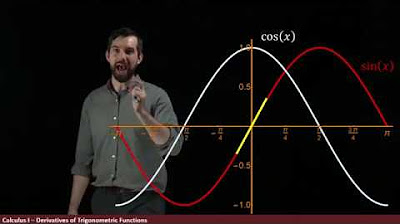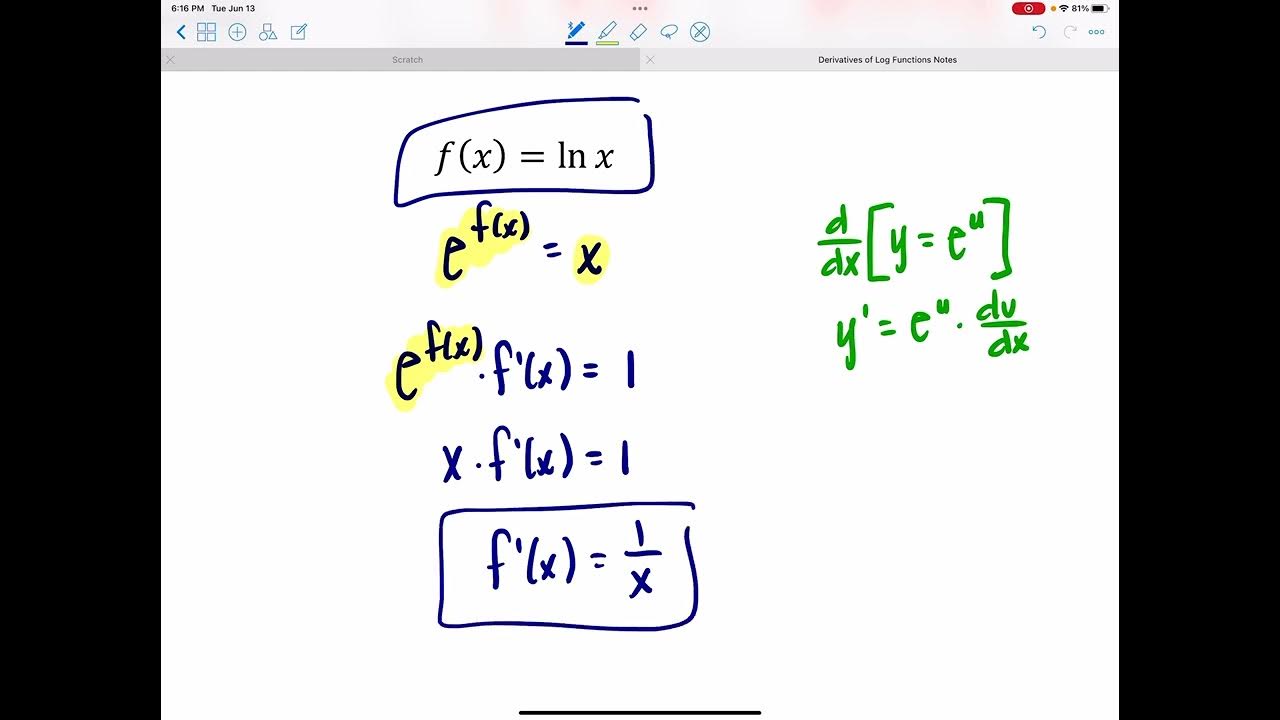Product and Quotient Rule
TLDRThis educational video script delves into the Product and Quotient Rules for differentiation, illustrating their application with examples such as the derivative of x^3*cos(x) and 2*sin(x). It also covers the simplification of these derivatives and introduces the Quotient Rule in a more complex context, providing a step-by-step explanation for its use with a function like sin(x)/x^3. The script advises against using the Quotient Rule when unnecessary and simplifies the derivatives of trigonometric functions like tangent and secant, concluding with a practical example of differentiating 3x^2*tan(x). The lesson is designed to help students understand and remember the rules for derivatives of products and quotients, as well as the derivatives of common trigonometric functions.
Takeaways
- 📚 The video script introduces the Product Rule and the Quotient Rule for calculating derivatives of functions.
- 🔍 The Product Rule is explained as the derivative of a product of two functions, which is the first function times the derivative of the second plus the second function times the derivative of the first.
- 📘 An example is given with \( y = x^3 \cos(x) - 2\sin(x) \), where the Product Rule is applied to \( x^3 \cos(x) \) and the derivative of \( 2\sin(x) \) is left as is due to a constant multiple rule.
- 👨🏫 The script emphasizes not to simplify the derivative expressions immediately, suggesting that simplification will occur later.
- 🤔 The Quotient Rule is presented as more complex, involving a quotient of functions where the derivative is the bottom times the derivative of the top minus the top times the derivative of the bottom, all divided by the bottom squared.
- 📉 The Quotient Rule is demonstrated with an example of \( \frac{\sin(x)}{x^3} \), which is simplified to avoid unnecessary complexity.
- 🚫 The instructor advises against using the Quotient Rule when there is a monomial in the denominator or a constant in the numerator, suggesting alternative simplifications first.
- 📝 The derivatives of tangent and secant are derived using the Quotient Rule, resulting in \( \sec^2(x) \) for tangent and \( \sec(x)\tan(x) \) for secant.
- 📈 The script also covers the derivatives of cotangent, cosecant, and the basic trigonometric functions like sine and cosine, noting a pattern where derivatives of functions starting with 'c' are negative.
- 📌 A mnemonic is shared to remember the derivatives of trigonometric functions: derivatives of functions starting with 'c' are negative.
- 📚 The final part of the script involves an example of finding the derivative of \( 3x^2\tan(x) \) using the Product Rule, and an exercise to find the derivative at a specific point using given function values.
Q & A
What is the product rule in calculus?
-The product rule is a fundamental theorem in calculus that allows you to find the derivative of a product of two functions. It states that if you have two functions, f(x) and g(x), the derivative of their product is f'(x)g(x) + f(x)g'(x).
How is the product rule applied to the function y = x^3 * cos(x)?
-In the script, the product rule is applied by treating x^3 as the first function (f) and cos(x) as the second function (g). The derivative of x^3 is 3x^2, and the derivative of cos(x) is -sin(x). Applying the product rule gives us the derivative of y as 3x^2*cos(x) - x^3*sin(x).
What is the quotient rule in calculus?
-The quotient rule is used to find the derivative of a quotient of two functions. It states that if you have a function f(x)/g(x), the derivative is [g(x)f'(x) - f(x)g'(x)] / [g(x)]^2.
Why is the quotient rule not recommended when there is a monomial in the denominator?
-The quotient rule is not recommended when there is a monomial in the denominator because it can be simplified by separating the terms and using basic differentiation rules, which is often simpler than applying the quotient rule.
What is the derivative of tangent(x) using the quotient rule?
-The derivative of tangent(x), written as sin(x)/cos(x), using the quotient rule simplifies to sec^2(x), which is the reciprocal of cos^2(x).
How does the script simplify the derivative of secant(x)?
-The script simplifies the derivative of secant(x), which is 1/cos(x), by applying the quotient rule and then separating the terms to get sin(x)/cos^2(x), which is the product of tangent(x) and secant(x).
What is a mnemonic to remember the derivatives of trigonometric functions starting with the letter 'c'?
-A mnemonic mentioned in the script is that the derivatives of trigonometric functions starting with the letter 'c', such as cotangent, cosecant, and cosine, are all negative.
What is the derivative of 3x^2 * tan(x) using the product rule?
-Using the product rule, the derivative of 3x^2 * tan(x) is (3x^2) * (sec^2(x)) + (6x) * (tan(x)).
Why is it important to simplify derivatives when possible?
-Simplifying derivatives is important for clarity and ease of understanding. It also helps in further calculations and can make the derivative more recognizable or match standard forms found in tables or references.
What is the derivative of x^4 * sin(x) if we apply the product rule?
-Applying the product rule to x^4 * sin(x), where x^4 is the first function and sin(x) is the second, the derivative would be 4x^3 * sin(x) + x^4 * cos(x).
How does the script handle the derivative of a function given as a product of three functions?
-The script suggests finding the derivative of each individual function first and then applying the product rule to the entire expression by treating it as a product of two functions, where one of the functions is itself a product of two other functions.
Outlines
📚 Introduction to Product and Quotient Rules
In this paragraph, the presenter introduces the product and quotient rules for differentiation. The product rule is explained as the derivative of a product of two functions. An example is given involving the product of x^3 and cosine(x). The quotient rule is also introduced, with a promise to show a related mnemonic in class.
✏️ Simplifying Expressions Using the Quotient Rule
This section explains how to apply the quotient rule to find derivatives of more complex functions. It emphasizes not using the quotient rule unnecessarily and provides a method to simplify expressions by rewriting them before differentiating. Examples are provided, showing the process step-by-step.
🔢 Applying the Quotient Rule to Trigonometric Functions
Here, the presenter demonstrates how to use the quotient rule for finding the derivatives of trigonometric functions like tangent and secant. The process is detailed with examples, and the resulting derivatives are simplified. Important identities and simplifications are highlighted, such as the Pythagorean identity and the relationship between trigonometric functions.
📏 Derivatives of Trigonometric Functions Starting with 'C'
The focus is on derivatives of trigonometric functions that start with the letter 'C' (cotangent, cosecant, and cosine), all of which result in negative derivatives. This section also includes an example of using the product rule with the function 3x^2 * tangent(x), reinforcing the process of applying the product rule in various contexts.
🧮 Using Given Data to Find Derivatives
The final paragraph discusses how to use provided data to find the derivative of a product of functions. An example is worked through step-by-step, demonstrating how to use the product rule formula and given values to compute the derivative at a specific point. The paragraph concludes with a solution to the example and a preview of the next lesson.
Mindmap
Keywords
💡Product Rule
💡Quotient Rule
💡Trigonometric Derivatives
💡Derivative
💡Constant Multiple Rule
💡Simplification
💡Chain Rule
💡Tangent
💡Secant
💡Cotangent and Cosecant
Highlights
Introduction to the Product Rule and the Quotient Rule for derivatives.
Explanation of the Product Rule: the derivative of a product of two functions is the first function times the derivative of the second, plus the second function times the derivative of the first.
Example using the Product Rule: y = x^3 * cos(x) - 2sin(x).
Application of the Product Rule to the example: differentiating x^3 and cos(x).
Simplification and the importance of not simplifying immediately after differentiation.
Introduction to the Quotient Rule: the derivative of a quotient of two functions is the bottom function times the derivative of the top, minus the top function times the derivative of the bottom, all over the bottom function squared.
Recommendation to avoid using the Quotient Rule when not necessary, especially with monomials in the denominator.
Example using the Quotient Rule: separating terms and simplifying before differentiating.
Development of derivatives for trigonometric functions: tan(x), sec(x), cot(x), and csc(x).
Key point: Derivatives of trig functions starting with 'c' (cosine, cotangent, cosecant) result in negative values.
Product Rule example with a trigonometric function: 3x^2 * tan(x).
Final example: finding the derivative using given data points and applying the Product Rule.
Reminder to verify answers, especially in multiple-choice formats.
Conclusion and invitation to continue the lesson in the next class.
Emphasis on the importance of understanding and practicing derivative rules for success in calculus.
Transcripts
Browse More Related Video

Quotient rule and common derivatives | Taking derivatives | Differential Calculus | Khan Academy

Quotient Rule | MIT 18.01SC Single Variable Calculus, Fall 2010

The derivative of Trigonometric Functions

Derivatives of Trigonometric Functions - Product Rule Quotient & Chain Rule - Calculus Tutorial

Derivatives of Log Functions

Higher Order Derivatives!
5.0 / 5 (0 votes)
Thanks for rating: